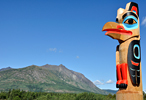General information about the country of Antigua and Barbuda.
Quick Facts About Antigua and Barbuda
- Capital: St John's, Antigua
- Population: About 85,000
- Official Language: English
- Currency: East Caribbean Dollar
- Largest Religion: Anglican
- Agriculture: cotton, pineapple, vegetables, livestock
- Visitors Per Year: about 240,000
- Popular Spectator Sport: Cricket
- Internet Country Code: AG
- Telephone Calling Code: +1-268
- Drives: on the left
Brief History of Antigua and Barbuda
First inhabitants were the Siboney who some believe settled in
the islands as early as 2400 BC. Later the Arawaks arrived from
Venezuela. The English began colonizing the islands 1932.
In 1674, Sir Christopher Codrington established a large sugar
estate on Antigua and he leased Barbuda to raise provisions
for his plantation. Barbuda's only town - Codrington - is
named after him. Antigua and Barbuda became an independent
nation on November 1, 1981.
Administrative Divisions and Largest Towns
The nation of Antigua and Barbuda is divided into six parishes,
all on the island of Antigua, and two dependencies, the islands
of Barbuda and Redonda. The six parishes, ordered by population
from largest to smallest, with capital cities in parentheses,
are Saint John (St. John's), Saint Paul (Falmouth), Saint Mary
(Bolans), Saint George (Piggots), Saint Peter (Parham), and
Saint Philip (Carlisle). The capital of the dependency of
Barbuda is Codrington and the dependency of Redonda does
not have a capitol town.
Wikipedia Introduction to Antigua and Barbuda
WikiMedia Atlas of Antigua and Barbuda
BBC News Antigua and Barbuda Profile
Antigua and Barbuda World Fact Book
See also
More About Antigua and Barbuda
Antigua and Barbuda Travel Guide
America Travel Guide


